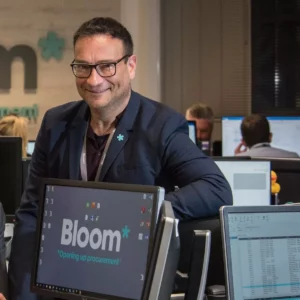How to structure a pitch deck that gets the attention of investors
You have a great business idea and you’re ready to pitch your business to investors. However, crafting a compelling pitch deck can be tedious and one of the hardest parts of being an entrepreneur.
You’re not alone, even some of the most successful entrepreneurs have grappled with pitch decks and pitching. One of those entrepreneurs is our very own Home Grown Ambassador, Nick Telson. Nick is the exited founder of DesignMyNight 2020 , founder of Horseplay Ventures, Angel Investor, host of the top 10 Global Business Podcast – Pitch Deck 🎙️.
As a top 35 Angel Investor in the UK (according to Stride VC) Nick knows a thing or two about what makes a pitch deck irresistibly ‘investable’. We learnt a lot from Nick during his master class for out members which you can watch here but today we thought it would be best to give you Nicks top tips on how to structure your pitch deck.
Make it Skimmable!
“Your pitch deck needs to pique the excitement and the interest of an investor VC or angel so they will then deep dive with you on a phone call or a meeting. The big trap a lot of people fall into is putting everything into a pitch deck.”
At Horseplay Ventures, Nick and his team receive around 50 decks per month, to capture his attention, it’s best not to create a deck that is almost 40 pages long.
“I just don’t read them all, you skim a deck, and you’re looking to see, is this an idea, what’s the team like, and that’s all you really need is skimmable…an angel does not want to read paragraphs and paragraphs of text so that’s the first thing to know.”
Is your pitch deck 15 – 20 pages long? if you’re over that, it’s probably too long.
What’s the problem?
The key to making your pitch deck flow is by following a very simple narrative of a problem.
- What’s the problem?
- What’s the solution?
- What are we solving out there?
- Why you?
- Why our investment team?
- Why now? (Why is this a good time for your business to receive investment?)
It all comes down to four things – Problem – Solution – Why us – Why now
Try to not forget to include your business proposal i.e how are you going to make money.
“You’ll be surprised to know how much that’s missed out on pitch decks! I personally like to see a forecast”
Toptal.com published a similar deck flow with a little more detail so if you need a more guidance, you can refer to the 10-pointer summary below:
- The Problem: Introduce the story by personalizing the problem, creating tension in your audience’s minds.
- The Solution: Offer a glimpse of hope, promising to resolve the problem.
- Product Features: Showcase the main features that make the solution possible, building your potential investors’ confidence in your solution.
- Market: Introduce your setting and characters. Show investors who stands to benefit. Start building a picture of customers in your investors’ minds.
- Competitive Landscape and Potential Risks: Increase the tension again by disclosing the risks and opportunities ahead.
- Revenue and Operating Model: Reassure your investors by demonstrating a persuasive plan for success.
- Traction: Increase potential investors’ confidence in your ability to execute by sharing your record of success.
- Projections: Build excitement by showing where you expect to be in five years.
- Team: Introduce your partners. Help investors relate to your company. Show why your line-up is qualified to execute what you’ve promised to do.
- Fundraise: Explain the role you’re asking these investors to play in bringing this product to life, and create urgency by showing why you need them now.
The who’s who.
You need to include who you are as a founder/s of your business and properly introduce your team. Nick says to be “..very self aware of the holes you need to plug. I think that’s extremely important when you’re speaking to an investor”. An example of this could be ‘We’re going to need a growth marketing strategist and that’s something we’re going to be hiring after this round’ or ‘I want to hire a CTO because I want to bring our tech in house’.
Graphics / Presentation
First and foremost, take the time to design it nicely.
“If I see a deck that is just white backgrounds with bullet points, if it looks like GCSE level computer science, I think ‘if they don’t have the know-how to make their pitch deck look good’ that would worry me.”
Have you heard of Canva? It’s a free tool with tonnes of decks or templates already that you can then just adapt to your brand colours, so take the time to make it look good.
“If your deck doesn’t have that ‘pzazz’ I would think, do they have the prowess to make their brand sing as well.”
Imagery brings your pitch deck to life, you can use free tools such as Unsplash or Getty or to find images that work for your brand. Without imagery, investors may think your business is bland and boring.
“Honestly, I see so many pitch decks that I open up and it’s just an empty sort of PowerPoint on the slide, I just don’t know if I can be bothered to read this.”
Impressing Angels and VCs to get your funding really isn’t rocket science but can become a lengthy process which takes you as the entrepreneur away from your business for a substantial period of time.
Remember, summarise your key points strategically without overdoing it.
We hope this break down has helped you and for even more tips you can watch the hour long masterclass with Nick here or read Toptal’s article here.
Related articles




A one-stop-shop for entrepreneurs and investors. What really sets Home Grown apart is their members’ events which provide access to valuable insights and support scaling founders on their growth journey.Richard Farleigh, Entrepreneur and Former BBC Dragon's Den
It’s always a delight to meet, network and entertain amidst the generally relaxed vibes that radiates throughout Home GrownGladstone Small
Home Grown is immersed with an overflowing energy, unrivalled facilities yet the club has a certain uniqueness.Luke Reed
What a special delight and home from home! I stay here whenever I come to London and their Scale-up events are on the money.John Courtney
We are all crying out for opportunities to bump into other people, to spark ideas off them that make us happier, more fulfilled and more imaginative: Home Grown is a forum for just this creative serendipity.Tas Tasgal
Home Grown is more to me than just my office in London. It’s a community. It’s a place to network with other business people. But most of all it’s got that super friendly and positive vibe that you just can’t wait to get there each time.Neil Thompson




















































































































































